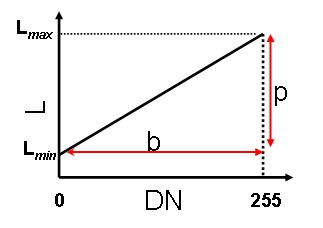Recent Comments
Archives
Categories
- No categories
Meta
7.4. Radiometric Calibration
Objectives
- To understand the methods used for radiometric calibration
- To understand concepts that underpin these techniques, particularly spectral radiance and spectral reflectance
There are four groups of techniques that are used in pre-processing remotely sensed imagery, namely:
- cosmetic operations
- radiometric calibration
- atmospheric correction
- geometric correction
We will turn our attention to radiometric calibration and atmospheric correction here.
N/B: The slides below will not show on the webpage, but you can save/keep them on your computer and view them using the Adobe Flash Player 32 you downloaded earlier
Radiometric calibration
Radiometric calibration is the process of converting image brightness values in a remotely sensed image to spectral radiance values. Spectral radiance is the amount of light within a given wavelength band recorded by a sensor for a given Image Field of View (IFOV). This is a complex measurement and the units used to measure it are also quite complicated. Spectral radiance is measured in Watts (a measure of power or in this context light) per metre squared (of the Earth’s surface within the field of view) per steradian (the angle for the field of view) per nanometre (of wavelength), abbreviated to W m-2 sr-1 μm-1. However, the pixel image brightness values collected by the sensor are provided in DN numbers. The DN numbers are intended to help store the remotely sensed image as efficiently as possible. Whilst they contain information about spectral radiance values in one pixel relative to other pixels, DN numbers are not measurements with known units. Spectral radiance is independent of the sensor, whereas a DN number will vary, depending on the sensor. For a given waveband for two different sensors, the same spectral radiance value may well be represented as two different DN numbers. For this reason, we often need a means of converting DN numbers into spectral radiance. This method of converting from DN numbers to spectral radiance is termed radiometric calibration. Radiometric calibration is therefore necessary if:
- we want to compare images from different times
- we want to work with images from different sensors
- we want to calculate physical properties, like spectral radiance or spectral reflectance.
Sensor calibration is the process used to convert from spectral radiance to DN numbers and it makes use of a linear equation:
DN number = x * spectral radiance + c
The equation has a slope (x) and a constant term (c). The slope (x) is sometimes known as a gain and the constant term is sometimes known as an offset. Spectral radiance is often represented as L. Thus:
DN number = gain * L + offset
This equation can be rearranged to calculate spectral radiance (L) from the DN numbers.

Practical Activity – Introduction to Envi
Download the practical instructions and remotely sensed imagery, and undertake the activities described in the practical instructions. This practical provides an introduction to the Envi digital image processing software. N/B: The questions in this practical are formative and are not graded(they are meant to enhance your understanding-if you want feedback on them you can post your question/answers on the discussion board).
References
Hall, F.G., Strebel, D.E., Nickeson, J.E., and Goetz, S.J. (1991) Radiometric rectification: toward a common radiometric response among multidate, multisensor images, Remote Sensing of Environment, 35, 11-27.
Note that these readings are optional.